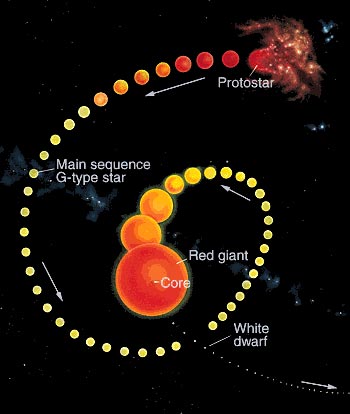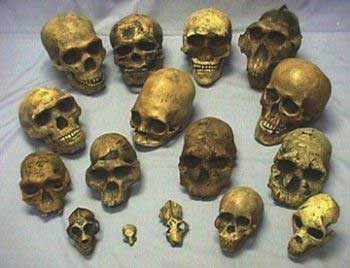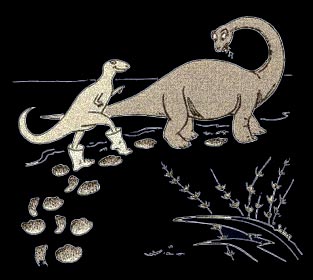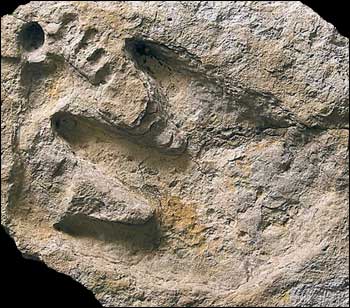
Latest info on stellar evolution:
An amateur astronomer witnessed the birth of a new star. The new object had appeared alongside the well-known gas cloud known as Messier 78. The star came out of its enclosing cocoon over the past few weeks. An urgent appeal has gone out to astronomers to monitor the object which is now known as McNeilʼs nebula. Here is the story at BBC News Last Updated, Thursday, 12 February, 2004
Speaking of evolution, I like to start with the stars. Stellar evolution is about as close to undeniable evidence as you can get. I recently wrote a young creationist named Anna, who asked me some basic creationist questions that she thought were unanswerable and told her to read Astronomy and Sky and Telescope magazine. Star formation is being observed and measured right now, via satellite telescopes that are able to record radiation at different levels of the electro-magnetic spectrum, like x-ray radiation, and other types (visible light can be seen by the human eye but visible light is only a tiny portion of the entire range of radiation lying along the electro-magnetic spectrum). Such satellite measurements include measuring the speed of gasses rushing together toward a central point of gravitational collapse. Fu Orionus, a new star, was observed brightening the sky for the first time decades ago. There is a lot of data on star formation at present, and more is being gathered all the time. Stars form in cloudy nebulas (regions of high gas concentration). And the ages of the stars in those nebulas is youthful, the ages of such nebulas also fall along a particular spectrum of ages as expected by the current theories of star formation. Nothing unexpected there. In fact even creationist astronomers have remarked how good the evidence for stellar evolution is. See these quotations from Creationists:
Stellar Evolution
- “…the theory of stellar structure appears to be founded on a good physical basis and…stellar evolution is intimately related to stellar structure…
- “If creationists wish to scrap stellar evolution completely, then it is incumbent on us to rework stellar structure and/or physics in a convincing fashion…
- “The standard observational tool used in studying stellar structure and evolution is the Hertzsprung-Russell (H-R) diagram… It consists of a plot of stellar luminosity increasing upward and temperature increasing to the left…Most stars are found on a roughly diagonal band called the main sequence (MS)…
- “This agreement is quite impressive and the physical assumptions that go into it are so well founded it is doubtful that many creationists would have much to argue with in main sequence (MS) stellar structure. However, what is generally called post MS evolution is not far removed from the brief outline of stellar structure given above.
- “The most massive stars may pass through successive steps of fusing helium nuclei with increasingly more massive nuclei up to iron…Note that these transitions have not actually been observed. However, they are based on physics principles and will naturally occur…
- “The upshot is that the most massive stars have MS lifetimes of only a few hundred thousand years (of course, still much longer than young-age creationists would allow), while the lowest mass stars have MS lifetimes approaching 100 billion years…
- “And evolutionary assumption concludes that the stars in a star cluster should form from a single cloud so that the members represent…a homogenous group. Different clusters should have different ages, and though they technically have different compositions, even large differences in composition do not seriously affect the overall appearance of an H-R diagram…
- “The agreement of the theory [of stellar evolution] is quite impressive…
- “[The expected evolutionary] trend between globular and open clusters is observed…
- “Evidence [exists] that the formation of planetary nebulae and the evolution of white dwarfs are related…These two ages have a very good correlation…
- “A similar relationship holds for neutron stars and supernova remnants. As with planetary nebulae, the expansion velocity and observed size of the remnant can be used to estimate the time since the explosion…Where a pulsar can be identified in a supernova remnant, the ages of the remnant and the pulsar are well correlated.
- “Very brief discussions of stellar structure and evolution have been presented. Though it would seem that creationists would not have much with which to quarrel in the former, most would largely dismiss the latter. However, the two are intimately related, and one cannot be rejected without seriously calling into question the other. We are appealing to readers to give much attention to the study of stellar evolution…”
— Danny R. Faulkner & Don B. De Young [young-universe creationists], “Toward a Creationist Astronomy,” Creation Research Society Quarterly, Vol. 28, Dec. 1991, pp. 87-91
“Perhaps the most important remaining question [in astronomy] for [young- universe] creationists is the origin of the turnoff points in the H-R diagrams of different clusters. The stars are real physical objects and presumably follow physical laws; we would rather not take the easy way out by saying simply that ‘God made them that way.’ But if creationists take the position of rejecting stellar evolution, they should provide a feasible alternative.”
— Paul Steidl [young-universe creationist], The Earth, the Stars, and the Bible (Grand Rapids: Baker, 1979), p. 153—as quoted by Howard J. Van Till in The Fourth Day: What the Bible and the Heavens Are Telling Us about the Creation (Grand Rapids: Eerdmans, 1986), p. 239
Also google the Ph.D. astronomers “Hugh Ross” (at Reasons to Believe) and “Robert Newman” (as The Interdisciplinary Biblical Research Institute) on the internet because they are creationist Christians who both agree that the evidence for stellar evolution is overwhelming, and they have even debated their young-earth creationist brethren on that point.
The creationist I mentioned above, named Anna, was persistent, however, and continued asking me more questions, that I replied to…
Anna: Ok, so every about what 20 years we have a star expolde, right?
Edward: Hello again Anna. I donʼt know what the average number of stellar explosions is in the cosmos, and I sincerely doubt that astronomers know either. It would be impossible to keep track of every exploding star in the visible cosmos. First of all, do you know what a “galaxy” is? It is a conglomeration of about a billion stars. We live in a spiral-shaped galaxy called the Milky Way and our planet is found circling only one star that is found on one of the spiral arms, closer to the outward tip of the arm than toward the center of the galaxy as a whole. In the beginning of the last century, telescopes could only see the stars in our galaxy. In fact, with the visible eye, that is all you see when you look up into the sky, just the stars of the Milky Way Galaxy, and of those, you can only distinguish about 8000 stars at most with the unaided eye on a clear night. But there are about a billion stars in our galaxy alone, most of which we canʼt see with the unaided eye, and beyond those stars in our galaxy there lay even fainter white dots in the sky that only telescopes can see. Each of those faint white dots, upon closer examination, turns out to be other galaxies. But at the beginning of the last century, astronomers thought those faint white dots were just cloudy nebulas of hot gas. Better telescopes were invented and those blurry nebulas were found to be a multitude of spiral shaped galaxies like our own. Then even better telescopes were invented, telescopes that circle the earth, like the Hubble scope, and we found out that there were about 50 billion galaxies out there, and today, with the latest satellite telescopes we know there are over 100 billion galaxies out there. In other words, if you raise your fist to the nighttime sky, the area of the sky that your fist covers, contains about a 100 million galaxies in the depths of space and time. But you canʼt see them. So I doubt that astronomers are able to keep track of all the stars in a 100 billion galaxies or how often a star in each of those galaxies explodes. Or course if you were just looking at our own galaxy, the Milky Way Galaxy, Iʼm sure they have some rough idea of how often such explosions occur just in our galaxy, and even where they occur most often. Recently, astronomers defined within our own galaxy, a “Galactic Habitable Zone” that has fewer cases of stars going nova than in other regions.
Anna: So why is there evidence that only about three hundred of them exploded?
Edward: I do not know where you got that number from, as I said, the cosmos is far too vast for astronomers to keep track of every exploding star. But there is one exploding star in particular that you should learn more about, since it provided some strong evidence in favor of an old-cosmos.
Anna: If the earth was indeed millions of years old woulnd there be more evidence of novas / super novas?
Edward: There is evidence of galaxies colliding in the present as well as in the past, there is evidence of stars still being born, and of stars exploding, and there are also some huge rings of matter that keep expanding from stellar explosions that took place in the distant past. Judging by the present measured speeds of the expansion of such huge rings of matter, their initial explosions had to have taken place long before the time when young-earth creationists say the world was created.
Anna: what are your thoughts on the Grand Canyon?
Edward: Are you asking whether I believe the Grand Canyon was formed by a single world-wide Flood? My answer would be no. And why is there only one Grand Canyon on the entire face of the earth? And why does it lay so far inland? Surely waters rushing off the continent during the months when the Flood subsided would have created canyons galore all along the ridges of the continents.
Anna: How do you belive it was created? Not by the river that runs through the bottom, i hope. It was made during the flood and all those layes of coal were to.
Edward: Steve Austinʼs Grand Canyon Erosion Argument: A Mathematical Sleight of Hand
A geologist reviews a creationist book on the Grand Canyon
Creation Walk Through the Grand Canyon
The Grand Canyonʼs geology, starting with the Cambrian, and going through several websites to a final conclusion, written by a geologist
The Entire Geological Column in North Dakota
A geologist (who is also a former young-earth creationist) reviews Answers In Genesisʼ attempt to defend Flood Geology
Assorted articles on Flood Geology, including a few on the Grand Canyon and one by me at the near end of the list.
Why Geology Shows Sedimentation to Be too Slow for a Global Flood, written by a former young-earther who is now a professional geologist
Anna: What are your theories on the Loch Ness Monster? Do you belive that its a living dinosoar?
Edward: The photograph that kicked off the craze for the supposed monster in Loch Ness, Scotland was taken in 1934. In 1994, one of the people involved in taking the original picture admitted it was a trick. The “monster” was created by attaching an artificial head to a toy submarine which was just over a foot long. Other evidence collected by scientists and skeptics over the years have exposed other photos as faked or misread. The claims that a huge monster exists in Loch Ness have also been debunked by research showing that such a creature could not survive on the food available in the loch; even less could a substantial colony of such creatures - necessary for the survival of individual creatures over the centuries - be supported. Furthermore, the lack of any credible physical evidence of a creature or a colony of creatures after six decades of intensive searching by numerous expeditions would seem to make Nessieʼs existence unlikely.
Anna: There has been proof of dinosoars living with humans and the bible talks about it to.
Edward: No it doesnʼt. The Bible in Job only speaks about Behemoth and Leviathan, two beasts of mythical proportions, perhaps modeled on some large animals, but mythically exaggerated. People in Jobʼs day didnʼt know what beasts existed in the world, all sorts of strange mythical beasts were invented, especially to live in the lands beyond the edges of the then known world. One of Jobʼs beasts even breathes fire. Why it didnʼt singe its own mouth, lips or nostrils is a good question. Why it didnʼt risk inhaling any of the fire into its lungs is another question since itʼs mouth and nostrils were filled with fire and smoke, and how it lit chemicals to produce flames is another question. No animal on earth produces flames (the bombardier beetle produces only hot liquid).
If you want to learn more about ancient mythical beasts in the ancient Near East and how the Bible came to also employ such stories in the book of Job, read, Slaying the Dragon: Mythmaking in the Biblical Tradition by Bernard F. Batto (Paperback - November 1992)











